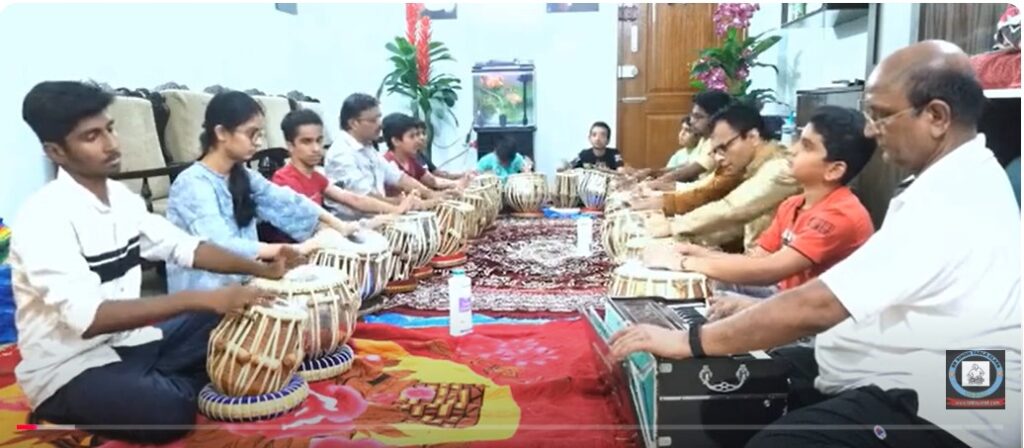The Forgotten Art of Tabla: Aarikuwari tirkit kayda-16 beat, The Forgotten Art of Tabla: Aarikuwari Tirkit Kayda in 16 Beats, The tabla, with its unparalleled rhythmic brilliance, has remained at the heart of Indian classical music for centuries. While many of its forms and compositions continue to thrive in performances, some of its intricate styles, such as the Aarikuwari Tirkit Kayda, have faded from the limelight. This blog takes you on a journey to rediscover this masterful tabla composition in Teentaal (16 beats), exploring its unique characteristics, significance, and why it deserves revival.
Base Aarikuwari Tirkit Kayda (Bol Breakdown):
Mukhda (Base Pattern):
Dha Tirkit Dha Ge | Dha Tirkit Dha Ge | Dha Tirkit Dha Ge | Dha Ge Na
The hallmark of this kayda is the repetition of the Tirkit stroke, which creates a flowing, cascading effect while maintaining the zigzag rhythm of the composition.
Why is the Aarikuwari Tirkit Kayda Forgotten?
The Aarikuwari Tirkit Kayda requires a high level of skill, focus, and dedication to master. Unfortunately, as tabla performances have shifted toward fusion and popular music, traditional compositions like this one are gradually becoming rare. Here are some reasons why it’s fading:
1. Focus on Simplicity in Modern Music:
The rise of Bollywood and fusion music has increased the demand for simple, accessible tabla rhythms. Complex kaydas, which require time and patience to appreciate, are often set aside in favor of more straightforward patterns.
2. Reduced Emphasis on Tabla Solos:
In classical music concerts, tabla solos were once a centerpiece. Today, they are often reduced to short accompaniments or omitted altogether, leaving little room for intricate compositions like the Aarikuwari Tirkit Kayda.
3. Decline of Oral Tradition:
Traditional tabla teaching relied on the guru-shishya parampara (teacher-student lineage) to preserve rare compositions. As fewer students dedicate themselves to classical training, the Aarikuwari Tirkit Kayda risks being lost.
The Beauty of the Aarikuwari Tirkit Kayda
Despite its decline, the Aarikuwari Tirkit Kayda holds immense beauty and significance for tabla enthusiasts. Here’s what makes it special:
1. Zigzag Rhythmic Structure:
The back-and-forth movement of strokes gives this kayda a lively and dynamic character. Its rhythmic complexity is a testament to the depth of tabla artistry.
2. Mastery of Tirkit Strokes:
The repetition of Tirkit—a rapid combination of finger strokes—is both challenging and captivating. Perfecting this pattern requires exceptional finger control and stamina.
3. A Platform for Creativity:
Once the base pattern is established, tabla players can expand upon it with variations (paltas), allowing for infinite creative possibilities.
Aarikuwari Tirkit Kayda: A Demonstration
Here’s an example of the Aarikuwari Tirkit Kayda in Teentaal, demonstrating the base pattern and a few variations:
Base Kayda (Mukhda):
Dha Tirkit Dha Ge | Dha Tirkit Dha Ge | Dha Tirkit Dha Ge | Dha Ge Na
Variation (Palta):
Dha Tirkit Dha Tirkit | Dha Ge Dha Ge | Dha Tirkit Dha Ge | Dha Ge Na
Advanced Variation:
Tirkit Tirkit Dha Ge | Dha Tirkit Dha Ge | Tirkit Tirkit Dha Ge | Dha Ge Na
Listen to It in Action:
[Insert audio link or embed tabla video performance]
Notice how the cascading Tirkit strokes flow seamlessly within the structure of the 16 beats. The variations add complexity while staying true to the essence of the composition.
Preserving the Legacy of Aarikuwari Tirkit Kayda
The Aarikuwari Tirkit Kayda represents the artistry and technical brilliance of tabla playing. To ensure its legacy lives on, here are some steps we can take:
- Integrate It into Modern Performances:
Tabla players can incorporate this kayda into fusion, film music, or even live performances to bring it to wider audiences. - Encourage Dedicated Learning:
Teachers and institutions must emphasize traditional compositions like this one in their curriculum, inspiring students to master these intricate forms. - Raise Awareness:
Concerts, workshops, and online platforms can help showcase the beauty of this kayda to new listeners.
Conclusion
The Aarikuwari Tirkit Kayda in 16-beat Teentaal is a masterpiece of rhythm, precision, and creativity. While it may not enjoy the mainstream spotlight, it continues to inspire those who delve into the depths of tabla artistry. Reviving this forgotten treasure is not just about preserving a composition—it’s about celebrating the profound heritage of Indian classical music.
If you’re a tabla enthusiast or curious listener, we encourage you to explore this kayda. Play it, listen to it, and share it, so that its magic can inspire generations to come. What are your thoughts on this timeless composition? Let us know in the comments below!



https://www.youtube.com/@BhagawanSingh


The Aarikuwari Tirkit Kayda in 16-beat Teentaal is a masterpiece of rhythm, precision, and creativity. While it may not enjoy the mainstream spotlight, it continues to inspire those who delve into the depths of tabla artistry. Reviving this forgotten treasure is not just about preserving a composition—it’s about celebrating the profound heritage of Indian classical music.
If you’re a tabla enthusiast or curious listener, we encourage you to explore this kayda. Play it, listen to it, and share it, so that its magic can inspire generations to come. What are your thoughts on this timeless composition? Let us know in the comments below!
